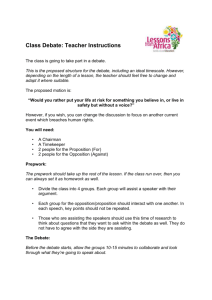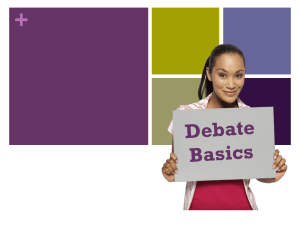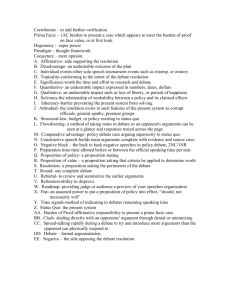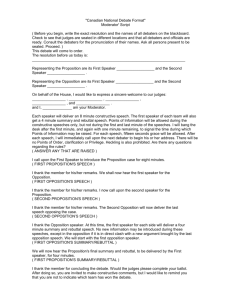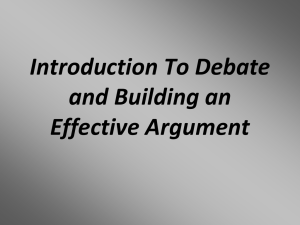Middle School Public Debate Program
advertisement
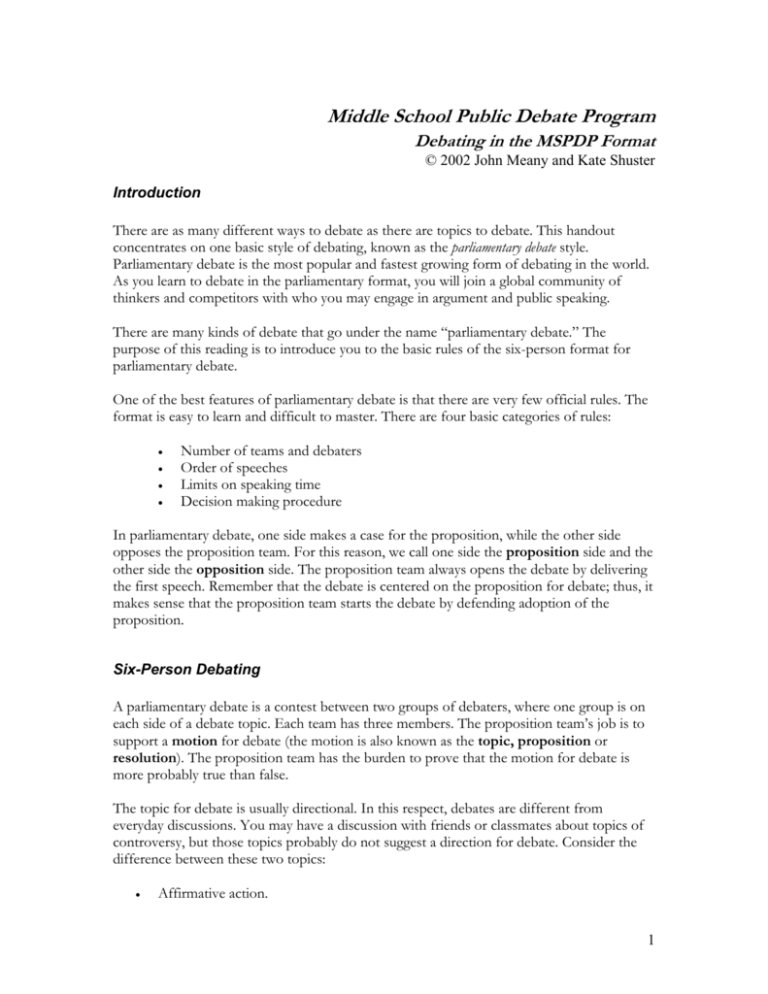
Middle School Public Debate Program Debating in the MSPDP Format © 2002 John Meany and Kate Shuster Introduction There are as many different ways to debate as there are topics to debate. This handout concentrates on one basic style of debating, known as the parliamentary debate style. Parliamentary debate is the most popular and fastest growing form of debating in the world. As you learn to debate in the parliamentary format, you will join a global community of thinkers and competitors with who you may engage in argument and public speaking. There are many kinds of debate that go under the name “parliamentary debate.” The purpose of this reading is to introduce you to the basic rules of the six-person format for parliamentary debate. One of the best features of parliamentary debate is that there are very few official rules. The format is easy to learn and difficult to master. There are four basic categories of rules: • • • • Number of teams and debaters Order of speeches Limits on speaking time Decision making procedure In parliamentary debate, one side makes a case for the proposition, while the other side opposes the proposition team. For this reason, we call one side the proposition side and the other side the opposition side. The proposition team always opens the debate by delivering the first speech. Remember that the debate is centered on the proposition for debate; thus, it makes sense that the proposition team starts the debate by defending adoption of the proposition. Six-Person Debating A parliamentary debate is a contest between two groups of debaters, where one group is on each side of a debate topic. Each team has three members. The proposition team’s job is to support a motion for debate (the motion is also known as the topic, proposition or resolution). The proposition team has the burden to prove that the motion for debate is more probably true than false. The topic for debate is usually directional. In this respect, debates are different from everyday discussions. You may have a discussion with friends or classmates about topics of controversy, but those topics probably do not suggest a direction for debate. Consider the difference between these two topics: • Affirmative action. 1 • The government should promote affirmative action. The first topic suggests an area for debate but does not suggest a direction for debate. The second topic is more similar to topics you may encounter in competitive or classroom debates, as it clearly points towards a direction for debate. Since the proposition team must defend the proposition, if they had to debate this second topic, what kind of arguments would you expect them to make? On the second topic, the proposition team would have to argue that the government should promote affirmative action. The other team in the debate is known as the opposition. The opposition team argues against the proposition’s support for the motion. If the proposition team argues that the government should promote affirmative action, the opposition team must then argue against that proposal. Listed below are some sample topics for debate. On each topic, what would you expect the proposition team to argue? What would you expect the opposition team to argue? • • • • • Advertising should be banned in schools. School newspapers should be allowed to publish whatever they want. Nations should eliminate their nuclear arsenals. Citizens should be allowed to carry concealed weapons. Governments should respect the rights of animals. To succeed in debate, you will have to get used to thinking about the way that topics divide up arguments between the proposition and opposition teams. The direction of the topic divides responsibilities between the two teams. One thing you might notice immediately is that the proposition will usually argue that a course of action should be done or a value position should be endorsed, while the opposition may simply disagree with the “should.” The opposition can sometimes easily accomplish this by arguing that a course of action should not be done or a value position should not be endorsed. The topics for parliamentary debate are flexible and may take many different forms. In a competitive, tournament situation, topics are announced before every debate. Once teams have learned the proposition for debate, they will have a period of time to prepare for the debate. Usually, teams will have fifteen minutes or more to prepare for the debate. After this “prep time” has ended, the debate begins. The Order of the Speeches There are six speeches in a six-person parliamentary debate. Every debater makes one speech. The first four speeches are known as constructive speeches. The constructive speeches are used to construct arguments for their side and to respond to arguments made by the other side. The proposition and opposition constructive speeches establish the core arguments for each team’s side of the topic. After the constructive speeches are over, the rebuttal phase of the debate begins. Every debate has two rebuttal speeches. In these speeches, each side summarizes the major arguments for their side and proposes the reasons why their team should win the debate. 2 Six-person parliamentary debates should have six speeches in this order. Time limits may vary, though we suggest the following limits for beginners: • First proposition constructive speech 5 minutes • First opposition constructive speech 5 minutes • Second proposition constructive speech 5 minutes • Second opposition constructive speech 5 minutes • Opposition rebuttal 3 minutes • Proposition rebuttal 3 minutes The proposition team opens and closes the debate. There is no preparation time for speakers during the debate. When it is their turn to speak, the next speaker should rise and immediately follow the previous speaker. Points of Information One unique feature of the parliamentary debate format is not accounted for in the above order of speeches. A parliamentary debate is not just a series of speeches in succession. In addition to using their designated speech time, debaters may present points of information. A point of information is a question or statement offered by a debater who does not currently hold the floor, presented to the debater who currently holds the floor. The parliamentary phrase “to hold the floor” simply means to have the ability to speak and not be called out of order. In governing legislative or parliamentary bodies, there are so many potential speakers that only one person can hold the floor at a time. In parliamentary debates, when you are speaking you are said to hold the floor. If another debater wishes to present a point of information, they cannot present their point until you recognize them. The way this works in debates is usually something like this: You: “….And so, as you can see, it is a good idea to let fast food franchises into our public schools to provide lunches for students.” Your Opponent: [rising] “Point of information.” By rising and stating “Point of information,” your opponent is signaling that she wishes you to yield the floor to her so that she can make her point. You have two options here: you can accept her point or reject her point. If you reject her point, you are refusing to yield the floor and she must sit down. Points of information are easily rejected, like so: You: “…And so, as you can see, it is a good idea to let fast food franchises into our public schools to provide lunches for students.” Your Opponent: [rising] “Point of information.” 3 You: “No, thank you.” If you accept her point, she may speak for up to 15 seconds and may ask a question or present a statement, like so: You: “….And so, as you can see, it is a good idea to let fast food franchises into our public schools to provide lunches for students.” Your Opponent: [rising] “Point of information.” You: “I’ll take your point.” Your Opponent: “But those fast food lunches will be less nutritious and therefore less healthy for the students who will eat them.” The time used for asking and responding to points of information comes out of the total speaking time allotted for the speaker. Points of information are a valuable and critical part of the process of parliamentary debating. They are only allowed during the constructive speeches in the debate. The first and last minute of every constructive speech are known as protected time. Protected time is time that the speaker has to introduce and conclude her speech without interruption by points of information. Any opponent who attempts to make a point of information during protected time is out of order, and should be told so: You (in the first minute of your speech): “ I would like to introduce our case for the proposition by quoting Homer Simpson, who said that…” Your Opponent: [rising] “Point of information.” You: “I’m sorry, but you are out of order. As I was saying…” The timekeeper or judge in the debate should signal the ends and beginnings of protected time, normally by slapping a table or desk. There is a judge or designated evaluator for each debate. In many debates, there are panels of judges, typically three or five judges per panel. If there is a panel of judges, they may decide the debate individually, allowing the majority opinion to decide the outcome of the debate. A debate may also have a designated timekeeper to track preparation time and speaking time. In the absence of a timekeeper, the judge usually keeps time. The timekeeper announces the end of preparation time. Technically, the debate officially begins immediately at the end of preparation time. The timekeeper signals time to the speakers during the debate with hand signals or a series of cards indicating remaining time. The timekeeper announces available time for points of information during the constructive speeches. After the first minute and before the last minute of each constructive speech, the timekeeper will “knock;” that is, rap her knuckles on a desk or table, slap a table with a gavel or palm of her hand, ring a bell, or make some other appropriate noise to signal the end or beginning of protected time. 4 Each round of tournament debating has a different topic. In competitive parliamentary debating, the proposition for debate is announced just before the debate begins. The tournament will have a central gathering place. At that site, a tournament representative will make a verbal announcement of the proposition for all participants. Bear in mind that parliamentary debaters must speak on a variety of topics with very little time to prepare. This practice mirrors and anticipates most of the public speaking opportunities you have in school, work, and other social settings. Normally, when we are called upon to speak in public or otherwise express our thoughts or opinions on a subject, we do not have much (if any) time to prepare. This is why we learn to debate – the training you will receive as a debater will help you keep your cool and succeed in the many speaking opportunities you will have in your lifetime. If the prospect of speaking with little preparation makes you nervous, you are not alone. Did you know that American adults rank public speaking as their number one fear? With practice and training in debate and public speaking, you will learn to overcome and cope with normal speaking anxiety. You may even discover that you enjoy speaking your mind on a variety of subjects, especially when you have the chance to persuade an audience. Speaker responsibilities – walking through a parliamentary debate In parliamentary debates, participants are presented with a motion for debate and have a scant 15 minutes to prepare. Parliamentary debaters do not read published material or argument briefs gathered prior to preparation time during their presentations; in fact, almost all competitive parliamentary debate leagues prohibit the use of quoted evidence in debates. In almost all parliamentary debaters, debaters speak from notes they’ve made during the preparation time prior to the debate or from notes they’ve made during the debate. This way, debaters can speak from their own authority about the issues for debate. This does not mean that debaters should feel free to make up information about the topic; on the contrary, this means that debaters are responsible for accurately communicating facts based of their knowledge and their research to the audience, the judge, and the other team. Because of the constraints of debate, each speaker has specific responsibilities for their part of the debate. The six debaters in a parliamentary debate inhabit six different speaker positions. Each debater occupies one of the available speaker positions: The first speaker for the proposition, or First Prop; The first speaker for the opposition, or First Opp; The second speaker for the proposition, or Second Prop; The second speaker for the opposition, or Second Opp; The opposition rebuttalist; and The proposition rebuttalist Each speaker position in parliamentary debate involves responsibilities for effective presentation, defense, and refutation. In addition, parliamentary debaters are members of teams and some responsibilities of speakers involve shared efforts with teammates. 5 We will discuss the duties of each speaker in turn, concluding with some general remarks about the responsibilities of debaters. First speaker, proposition (a.k.a., “ first prop constructive”) The opening speaker in the debate makes a case for the proposition. To make a case, a speaker offers a logical proof, a demonstration that the proposition for debate is more probably true than false. The first speaker for the proposition interprets the topic for debate, defining any unclear terms or otherwise clarifying the foundation for argument. This first proposition speaker may offer a brief history of the issue for debate. Parliamentary debate topics come from a wide variety of areas. Your judges or audience will probably not have precisely the same knowledge base as you. If you provide a history of the issue in controversy, you will assist the judge so that everyone in the debate is on the same page or has the same background information. After the opening speaker provides a clear foundation for the debate, she presents a case, that is, a group of arguments that support of her interpretation of the proposition. The case for the proposition typically consists of three or four main arguments with corresponding examples or other forms of contemporary or historical evidence. You make a case for different propositions in everyday discussions but have probably never thought of your arguments in these terms. How do you convince your friends to go and see a particular movie? You offer several lines of argument, or reasons to prefer your choice of movie. This is called making a case for your position. The first proposition speaker must prove the proposition for debate. The case for the proposition will typically consist of three or four major arguments, with corresponding examples or other forms of contemporary or historical evidence. For example, on the motion, “This House would remove junk food from schools,” an opening speaker might organize her major arguments in the following manner: 1. Eating junk foods like soda and chips causes obesity, diabetes, and heart disease. 2. When students eat a lot of high-sugar foods during the day, that hurts their ability to pay attention and increases the likelihood that they will fall asleep in class. 3. Banning junk food in the schools will be an important step towards solving these problems, because students will eat healthier foods in their cafeterias. What are some other arguments you could advance in favor of a ban of junk food in schools? The opening speaker should have enough reasons and examples to make concise, complete, and compelling arguments on each of these issues. At the end of her speech, the speaker 6 should remember to offer a summary of her speech to show how her arguments prove the proposition for debate. First speaker, opposition (a.k.a. “first opp constructive”) The opposition team provides clash in the debate. Clash, one of the fundamental principles of any kind of debate, is simply what happens when arguments directly oppose each other, or clash against each other. The opposition team provides clash when they attempt to undermine the logic of the proposition team’s case. The opposition argues that the topic, as interpreted by the proposition team, does not hold. The first opposition speaker uses tactics of direct and indirect refutation to counter the proposition team’s case. The opening speaker for the opposition may challenge the definition of the motion or the proposition’s decision framework of the debate. (See the chapter on topic interpretation for more on arguing theses issues). The first opposition speaker may also challenge the main arguments of the proposition’s case. Refuting the main points of the case, that is, disputing the argument analysis or fact claims of the opening speaker, is called direct refutation. The opening speaker for the opposition should critically evaluate the first proposition speaker’s arguments, pointing out inconsistencies, gaps in logic, argument fallacies, improper causal chains and exaggerated claims. This speaker might also offer counters to the examples presented in the proposition case. The opposition could also promote clash with the proposition case through indirect argumentation. You practice indirect argumentation when you bring up critical issues involves issues that are not formally included in the proposition team case. For example, if the first proposition speaker makes an argument for massively increasing funding to schools nationwide but fails to deal with the potential impact such a policy might have on the finances of the nation, you might bring up this problem in your speech. The best first opposition speakers know that they should present some combination of direct and indirect refutation. They must carefully select opposition arguments that will be relevant and effective for proving that the proposition, as interpreted by the proposition team, is more likely false than true. The opposition does not have to disagree with every argument that the proposition team makes in their case. This strategy is not effective and can be tiresome for a captive audience. Often, it is a good idea if the opposition team agrees with a proposition argument. This practice, called strategic agreement, can help the opposition team focus the discussion on those points that they feel are critical for winning the debate. In the opening speech, opposition debaters should at least account for all the major arguments of the proposition case. The opening opposition speaker should do this in a forthright and formal manner, making it obvious to the judge that they have dealt with all the major elements of the proposition case. The first opposition speaker should say something about each of the major issues of the case. She can do this by identifying points of agreement and relocating the core issues of the debate to other matters, or by directly or 7 indirectly disputing the proposition claims. Make sure that the first opposition speech communicates to the judge that the opposition team has a credible and strong strategy for defeating the proposition case. First impressions matter in debate as well as in life. Even if you are unsure of your arguments, it is important that you always sound credible and effective. This confidence may not come easily at first, but with practice you will sound more and more confident. Basically, the opening opposition speaker should try to identify and flesh out two or three main lines of argument against the proposition case. For example, you might advance two lines of argument to address the core issues of the case (direct refutation) and one new argument that could undermine the proposition position in the debate but, at the same time, is not an idea articulated in the opening speech (indirect refutation). Using the example of the school junk food case given above, an opening opposition speaker might advance the following three lines of argument: 1. Banning junk food will not solve the problem, because students will just go off campus or to vending machines to get their sugary, high-fat snacks. 2. The problem is not junk food; the problem is actually that students don’t get enough exercise. The proposition’s case does not deal with the root cause of the problem. 3. Banning junk food will only make the problem worse – schools will lose money from food providers like Taco Bell. That money pays for gyms and field trips as well as other activities that keep students healthy. What are some other arguments you could make against the proposition’s case? How do the arguments for the case stack up against the arguments for the case? Second speaker, proposition (a.k.a., “Second prop constructive”) The second constructive speech for the proposition team is that team’s last opportunity to introduce new arguments and issues. The only stand on the floor for the proposition, after this constructive speech, is the final rebuttal speech in the debate. This is a particularly important speech for the proposition, as it immediately precedes two consecutive opposition speeches, called the opposition block. The “opposition block” is composed of the second opposition constructive speech, and the opposition rebuttal speech. The opposition speeches give that side of the debate 8 consecutive minutes to advance arguments. The second proposition speaker must convincingly prove her side’s case to withstand the serious forthcoming opposition assault. The second speaker for the proposition must answer all of the major objections to the case offered by the opening speaker for the opposition. In addition, this speaker must reestablish the principles of the case as initially presented by her colleague in the first proposition speech. In doing so, she might supplement her colleague’s reasoning, offer additional examples or otherwise amplify the opening presentation. The second proposition speaker must address the proposition’s claims specifically and in order. 8 Let’s imagine that you were the second proposition speaker in the hypothetical junk food debate we’ve been following for the last few pages. How would you go about answering the opposition’s arguments and rebuilding your case to prepare for the coming opposition arguments? First, you would begin your speech by briefly summarizing the arguments that your side has already made for the proposition. After this introductory phase of your speech, you would then proceed to answer the arguments made by the opposition, using those arguments as opportunities to further solidify and expand your case. You might begin this process by saying: “They say that students will just go off campus to buy food, but.…” After you provide a response to their first argument, you should move to their second: “They say that the real problem is a lack of exercise, but banning junk food is a good first step….” You can see from this example how your refutation of the opposition’s arguments might proceed. It is important to make sure that you correctly allocate your time in this speech. Make sure that you allow yourself enough time to appropriately address all of the opposition’s arguments. After you have refuted all of the arguments advanced by the opposition, the second proposition constructive speaker should remember to close with an appropriate conclusion. This usually includes some sort of summary of the debate thus far, where the speaker explains why the proposition should win the debate despite all of the arguments made by the opposition up to this point. Second speaker, opposition (a.k.a., “ second opp constructive”) This is the final constructive speech in the debate for the opposition team. No new arguments or issues may be introduced after this speech by the side opposing the proposition. The second speaker for the opposition has several options for her speech. She may continue the objections of the first opposition speaker to the proposition team’s case; present new arguments against the proposition team (these arguments may be either direct or indirect refutation); and evaluate inconsistencies between the arguments of the first and second proposition speakers. It is important to expand the arguments from the first opposition speaker. It is equally important to answer or account for the key issues of the second proposition speaker. The opposition team, in their second speech, should be careful about introducing new arguments or unnecessarily expanding arguments in the debate. The second opposition speaker should effectively summarize issues, explaining carefully the impact of each argument. An argument’s impact is the way an argument plays a decisive role in the outcome of the debate. The “therefore” step in the four-step refutation method is a way of impacting an argument. Opposition rebuttalist This is the summary speech for the opposition team, the last opportunity this side will have to explain winning arguments. Rebuttals are an opportunity to contrast the main lines of argument of the proposition and opposition. The speaker should select from among the 9 issues of the debate. It is not possible to cover every argument in the debate. There are likely to be too many argument points from the constructive speeches in the debate, and the rebuttalist has approximately one-half the allotted time of the constructive speakers. The opposition rebuttal speaker should focus attention on the critical two to four major issues that might tip the debate to the opposition side. The opposition should select more than one issue. Multiple, independent winning arguments may increase the probability that the opposition will succeed in the debate. These arguments must have a foundation in the constructive speeches. New arguments should not be introduced in the opposition rebuttal. The opposition rebuttalist should carry through important issues from her opening speech in the debate, as well as her partner’s constructive speech. However, the speaker should not just repeat arguments from the second opposition constructive speech, as this is not an effective use of time. Proposition rebuttalist The proposition has the final speech in the debate. This speech should effectively summarize the entire debate. The proposition rebuttalist has similar goals as the final opposition speaker. The final rebuttalist should extend the arguments from the constructive speeches, taking care to answer the major arguments from the opposition speakers, particularly the final opposition stand on the floor. The proposition rebuttalist should offer multiple, independent proofs of the topic to increase the probability that any single idea will be enough for a victory. The proposition rebuttalist can answer any new arguments that were made in the second opposition constructive speech, because the final rebuttal is the first opportunity in the debate that the proposition team has to refute these issues. Although the answers to the new arguments of the second opposition speaker may appear to be “new,” they are not new arguments in the debate. They have their foundation in a constructive speech. 10


